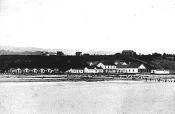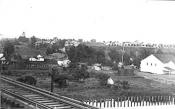Historical Snapshots 1800s

Capitola Was Once a Part of the Town of Soquel
Camp Capitola was founded at Soquel Landing in 1874. The founder, S.A. Hall, had leased the acres near the beach from F.A. Hihn, and established the camp on the recommendation of his daughter, Lulu Hall Green Wolbach. Lulu, a school teacher, suggested the name Capitola based on the series of popular novels by E.D.E.N. Southworth, featuring a heroine named Capitola. Both Hall and his daughter were active in the Soquel community and were among the founders and builders of the Soquel Congregational Church. (Soquel Pioneer Association photograph)

Cahoon's Mill, Soquel
Soquel pioneer Benjamin Cahoon ran an early sawmill on the Soquel River, a few miles above the town of Soquel. His son, Edwin B. Cahoon, later turned his father's mill site into a mountain resort called "Fern Gulch." Using his experience as a resort manager, the younger Cahoon took over the lease for Camp Capitola in 1886 and made improvements that gave stability to the resort. (Soquel Pioneer Association photograph)

Camp Capitola - 1875
A view of Capitola in 1875, the year after it was founded. The only entrance was Wharf Road, and there was no bridge yet built across the creek. The trestle for the Santa Cruz-Watsonville Railroad is newly completed. At the bottom of the picture is Camp Capitola's first hall, which supplied food and entertainment for the campers.

Camp Capitola, mid 1880s
Capitola's wharf was 1200 feet long at the time this photograph was taken in 1884. New cabins had replaced many of the tents at the center of the village.

Capitola's First Hotel, ca. 1884
This photograph, circa 1884, was taken looking toward what is now called Depot Hill. It shows the original 35-room Capitola Hotel and its bathhouse along the bluff. Above it is the first road to the top of the bluff. Six small cabins sit where the two-story Six Sisters are today.

Camp Capitola, circa 1890
At the far left of this photograph, taken about 1890, is the Lewis House, a hotel operated by Donner party survivor Patty Reed Lewis. The tall tank house marks the location of Capitola's reservoir. At the far right is the camp's skating rink that became famous in the Twenties as the Hawaiian Gardens Night Club. It burned in 1933.
